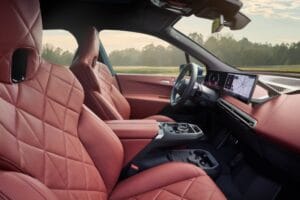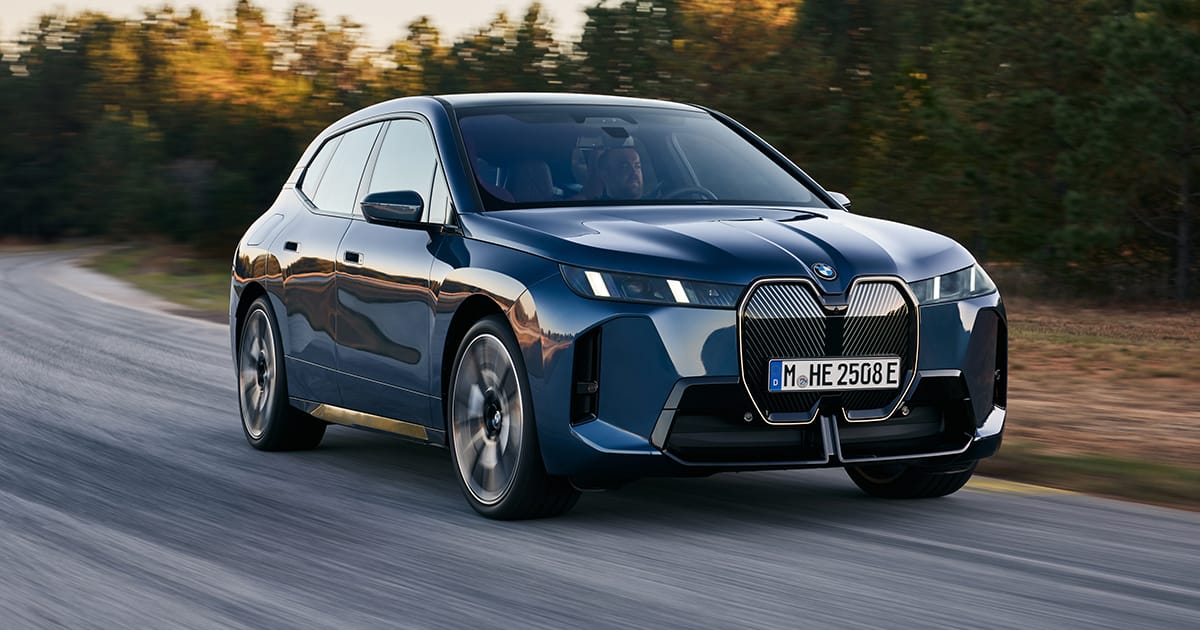One of BMW’s first quirky electric car offerings was the i3. It was small, and some versions even included a gasoline range extender using the engine from a BMW scooter. Wow — how far we’ve come. The new BMW iX is a luxurious five‑passenger SUV with an open, airy cabin and a usable trunk space. BMW calls it an SAV (Sport Activity Vehicle). Fun fact: there isn’t even a firewall tunnel for a transmission, so you can rest your foot beneath the center stack where a storage area would typically sit. It feels like the world’s most luxurious golf cart (in a good way). You really get an SUV that can tackle winding roads, eliminate visits to gas stations, and pamper you in the process.
Latest BMW Battery Technology
 My iX xDrive 45 tester showed 350 miles of range when it dropped off. According to BMW engineers, the increased efficiency of the new iX comes from the first-ever use of silicon-carbide (SiC) semiconductor components in a BMW EV—specifically in the inverters. Using a SiC inverter means more efficient energy conversion within the drivetrain. Silicon-carbide semiconductors perform better under high temperatures and with lower losses compared to conventional silicon.
My iX xDrive 45 tester showed 350 miles of range when it dropped off. According to BMW engineers, the increased efficiency of the new iX comes from the first-ever use of silicon-carbide (SiC) semiconductor components in a BMW EV—specifically in the inverters. Using a SiC inverter means more efficient energy conversion within the drivetrain. Silicon-carbide semiconductors perform better under high temperatures and with lower losses compared to conventional silicon.
The engineers dug into inverter technology to optimize the power electronics of the drive system. This ensures high efficiency in transferring energy from the high-voltage battery to the electric motor. The innovative silicon-carbide inverter module helps maximize the electric motors’ peak performance and efficiency—and thus the iX’s range.
Thanks to further development of performance electronics and adjustments to wheel bearings and low-rolling-resistance tires, the new iX offers about 10 % better range than its predecessor. The high-voltage batteries in the latest iX models use BMW’s fifth-generation eDrive tech, including a new battery management system that optimizes efficiency. A new cell design gives the iX xDrive45 a net usable energy capacity of 100 kWh. It can even tow up to 3,500 pounds. The engineers left no stone unturned in their quest for efficiency.
Looking Down the Road
 Maximizing range helps reduce range anxiety. On a 120-mile trip, I was left with over 60 % battery remaining—with the air conditioning running. For longer journeys, BMW provides a mode that limits performance and scales back HVAC functions to eke out additional miles.
Maximizing range helps reduce range anxiety. On a 120-mile trip, I was left with over 60 % battery remaining—with the air conditioning running. For longer journeys, BMW provides a mode that limits performance and scales back HVAC functions to eke out additional miles.
In everyday driving, the latest software includes adaptive recuperation, which helps extend range by intelligently adjusting regenerative braking. BMW networks the drive control system with navigation data and driver-assist sensors to adapt energy recovery to traffic conditions. For example, regenerative braking power increases when approaching a junction, and more energy is captured during downhill coasting.
Highway Assistant
 The iX is a glorious highway cruiser—especially with the Highway Assistant. The ADAS suite includes Forward Collision Mitigation, Active Blind Spot Detection, and Lane Keeping Assistant. When combined, you get BMW’s Highway Assistant, which works similarly to GM’s SuperCruise.
The iX is a glorious highway cruiser—especially with the Highway Assistant. The ADAS suite includes Forward Collision Mitigation, Active Blind Spot Detection, and Lane Keeping Assistant. When combined, you get BMW’s Highway Assistant, which works similarly to GM’s SuperCruise.
On suitable divided highways, drivers can remove their hands from the wheel at speeds up to 85 mph (while the system monitors traffic and conditions). You’ll see an icon in the instrument cluster and two green LEDs on the steering wheel when it’s active. The system also includes Active Lane Change with eye activation—you need to glance into the blind spot before it will perform a lane change automatically.
Initially, I was skeptical, but I ended up preferring the “look-then-change” gesture instead of reaching for the turn signal. I do miss dedicated distance controls like those in many adaptive cruise systems, but BMW’s self-adjusting functionality worked well in the iX and maintained safe following distances in most scenarios.
Crystal Interior & Premium Details
 I adored the interior crystal elements—gear selector, seat adjustment switches, iDrive controller—they’re exquisite. The Climate Comfort Package adds heated surfaces to the instrument panel, glove box, door panels, center armrest, and rear seats.
I adored the interior crystal elements—gear selector, seat adjustment switches, iDrive controller—they’re exquisite. The Climate Comfort Package adds heated surfaces to the instrument panel, glove box, door panels, center armrest, and rear seats.
The seats themselves are works of art: extremely comfortable, visually stunning, and featuring a tasteful pleating pattern. Massage is available for added comfort.
The Panoramic Eclipsing Roof enhances cabin openness with a one-piece glass span over both rows. Instead of a roller blind, it uses electrochromic shading that activates at the touch of a button.
The Bowers & Wilkins Diamond Surround Sound System, with 30 speakers and bass exciters in the front seats, delivers a rich, precisely balanced audio experience. Four “bass-shaker” transducers beneath the seats add tactile bass (“4D” listening), and there are headrest speakers too. B&W has crafted an immersive sound experience—yes, you feel the bass, but in a refined, tasteful way (not an over-the-top theme-park ride).
My iX tester stickered around $96,000. It’s not cheap—but it’s competitive among luxury electric SUVs. Considering the sublime seats, crystal touches, and driving dynamics, it arguably delivers value. You could opt for a less expensive EV like the Tesla Model Y, but the iX’s distinctive touches and road manners make it stand out.

